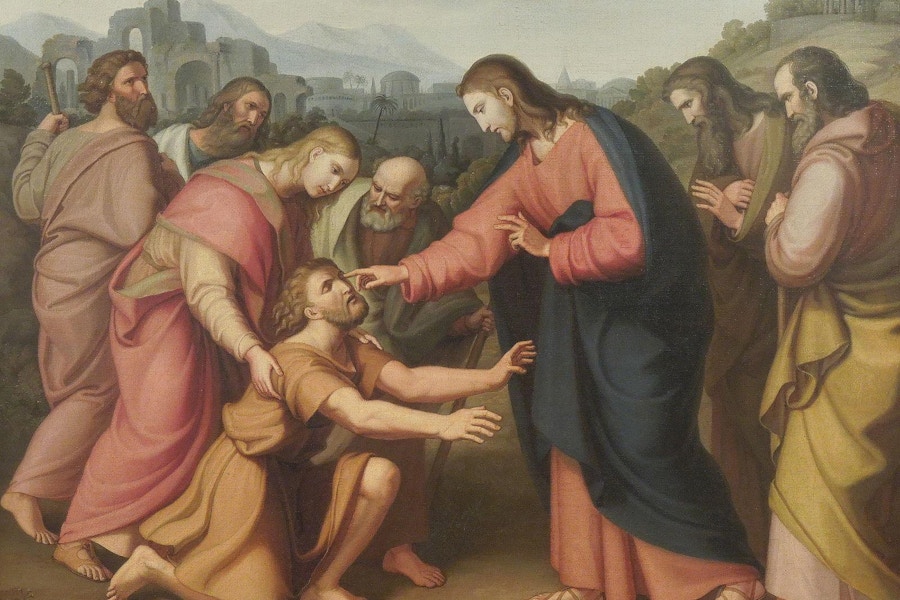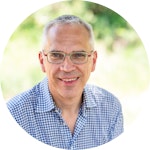Introductory Note:
In this celebration of the life of Bill Vaswig, Renovaré Ministry Team and Board member James Catford shares a story both personal and universal. Bill, who in the words of Richard J. Foster graduated this life summa cum laude just two days before his 80th birthday in 2011, lived an overflowing life as a husband, father, Lutheran pastor, and friend of the Renovaré community. He also was known for his life of preaching and prayer. In fact, he was the founder and first president of Preaching and Prayer Ministries, Inc., which he founded in 1978. We invite you to pull up a chair and learn a little bit more about the ministry of healing prayer and Bill Vaswig in this first of a two-part tribute and exploration.
James chatted with Nathan Foster this week on the Renovaré podcast about Bill Vaswig. Also, be sure to check out the conversations between James and Bill about Healing Prayer on our Audio and Video Resources page.
(Original British spellings and punctuation retained.)
Renovaré Team
At the tender age of twenty-three I was assigned to lead a student outreach program with a local church in the East End of London. The British equivalent of InterVarsity thought I was qualified to supervise a sizeable group of young people ministering in one of the most deprived communities in Western Europe.
On the team were undergraduates with a variety of views about healing. It fell to me to help them process what they were hearing and seeing in a church that believed strongly that God heals today. I’m not at all sure that the confidence placed in me was justified, but I sure learnt an early lesson about God.
I was fascinated to see how theology and belief played out in the way the team responded to the work of the Spirit in this frontline context. When healing meetings were held, several students sought me out to share their experiences and seek counsel. Some had themselves come from churches that emphasised that the gifts of the Early Church are available today; yet when they saw what appeared to be a dramatic healing taking place they literally ‘couldn’t believe their eyes’. One young man remarked to me: ‘I know I ought to believe what is happening, but somehow I can’t’.
Other team members had been taught that the ‘spiritual gifts’ had died out with the completion of the New Testament, yet they too had an unexpected reaction. As one put it, ‘I realise I’m not supposed to believe in this stuff, but I also know that God is big enough to do this kind of thing’.
Reflecting on these responses, it became clear that the key factor here was not theology but maturity. The students who could not take it in, even though their theology said they should, were less developed in their knowledge of God than the ones that had been taught that the gifts had ceased long ago. This suggests a necessary caution when it comes to giving a commentary on the highly-charged subject of healing. It is perfectly possible for people to profess belief in something (and even think that they believe it) but, in reality, they don’t actually know what they are talking about. In some Christian circles the ‘knowing’ bit of faith has become detached from the ‘talking’ bit.
For ten years until his death in 2011, I had the joy of walking alongside someone who really did know a considerable amount about healing. Pastor Bill Vaswig was the founding leader of Preaching and Prayer Ministries and taught me that prayer is not just about head-knowledge but about the heart. It is as much about posture as it is about process and that’s why books and articles on healing have their limits.
Healing presence
The greatest gift of healing that we can give to anyone is the gift of our presence. Few will argue with this. Whatever else is said about the work of the Holy Spirit and the validity or otherwise of the gift of healing, nothing can be substituted for our presence with a person who is unwell, hurting or broken.
Bill showed me that for people seeking the Kingdom, presence is first and above any other intervention that might be appropriate. In healing services where the meeting is full of excitement and emotions are running high, the personal and pastoral needs of the individual can easily be overlooked. This is especially true if the intention of the experience is ‘getting healed’ rather than entering further into the Kingdom and becoming more like Jesus.
Much damage can be done by truncating the good news of Jesus Christ to a set of results that approximate to what, on the surface, looks like a healthy person. While Jesus healed many who came to him, his teaching was that the priority is what is happening on the inside. This is the secret work of the Spirit where the seed is put into the ground and, by definition, dies; but then it miraculously starts to germinate and grow (Mk 4:31).
Occasionally stories emerge of people who have been harmed by those who reduce the Gospel to a narrow understanding of just getting ‘saved’ or just getting ‘healed’. But we know that God’s real agenda is for us to become more like Jesus and to enter a deep, personal and abiding relationship with him. When this is understood as the goal then it is possible to look at the healing of the body or the mind in a much broader context. The presence of a committed, caring and kind person alongside the one who is sick can in itself bring a degree of inner healing. Especially when that person is feeling isolated, abandoned or rejected by family, friends or work colleagues. Mother Teresa famously said that ‘the greatest disease in the West today is not TB or leprosy; it is being unwanted, unloved, and uncared for. We can cure physical diseases with medicine, but the only cure for loneliness, despair and hopelessness is love.’ In this way healing is a gift that everyone can have.
The gift nobody wants
Over the first three hundred years of the Church there are reports of healing being relatively common in the communities where Christ was honoured and followed. Certainly the misery of sickness and death was at least as common during these times as during Christ’s visible ministry on earth, and the need for healing and wholeness was considerable in a world that was largely illiterate and unable to read or access the Scriptures.
Gradually, the ministry of healing became restricted to the clergy and one of the most visible ways God shared his love with his people was withdrawn from use. In the ensuing centuries the gift fell into greater and greater neglect and in both England and France only the king was allowed to hold healing services. One example is the report in Shakespeare’s play Macbeth where,
All swoll’n and ulcerous, pitiful to the eye, The mere despair of surgery, he cures, Hanging a golden stamp about their necks, Put on with holy prayers, and ‘tis spoken, To the succeeding royalty he leaves The healing benediction.
(Act 4, scene 3)
Successive monarchs had the ‘royal touch’ and conducted public services attended by hundreds and thousands of people. King Charles X of France presided over the last of these in 1825. ‘When we consider’, comments Francis MacNutt, ‘that scrofula was a foul-smelling disease featuring oozing pustules, as well as realising how tiring and difficult these healing ceremonies must have been, we can see how important healing services were to kings and people alike’. (The Near Perfect Crime: how the church nearly killed the ministry of healing. Chosen Books 2005, p135).
Elsewhere there were small signs that belief and practice had not totally died out. Then on 9 April 1906, at a meeting arranged in Los Angeles by William J. Seymour, a poorly-educated African-American who was blind in one eye, ‘the power fell’, meaning a dramatic outpouring of the Holy Spirit took place. Within a few days a movement, with a strong emphasis on the gifts of the Spirit, including healing, was started. From humble beginnings in Azusa Street it rapidly swept the world. Now the highly-restricted ‘royal touch’ was being exercised freely by the ‘royal priesthood’ (1 Pet 2:9) of ordinary people seeking the Kingdom of God.
On Friday, we will finish this reflection on Healing Prayer with “The Royal Touch, Part Two”.


